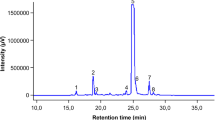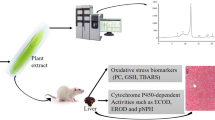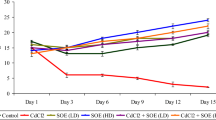Abstract
Arsenic exposure is associated with the induction of hepatotoxicity. Current study was aimed to investigate the hepato-protective ability of polyphenolic components of Tamarix aphylla (TA) ethanolic extract against sodium arsenite (SA)-induced liver injury of rats. Significantly higher quantities of phenolic (318.7±2.5 mgg−1GAE) and flavonoid (250.69 ±3.3 mgg−1QE) contents were present. Inhibitory concentration (IC50) exhibited an excellent potential for antioxidant (IC50= 25.99 μg/mL) assay. High performance liquid chromatography (HPLC) confirmed the existence of myercetin (10.40ppm), sinapic acid (2.131ppm), kaempferol (0.486ppm), caffeic acid (5.094 ppm). Forty-two rats were divided into 7 groups. Group 1 received normal saline (2 mL/kg/day, orally for 21 days), Group 2 received SA (10mg/kg/day for 21 days), and Group 3 received SA alone for 7 days (10mg/kg) and continues with silymarine for 21 days (25mg/kg orally). Group 4, 5, 6 received SA alone for 7 days and continue with TA extract up to 21 days (125mg/kg, 250mg/kg, and 500mg/kg orally) respectively, and Group 7 received TA extract (500mg/kg) for 21 days. SA was administered to all treated groups for 21 days. Treatment with polyphenolic ethanolic extract of TA restored the hepatic indices and oxidative markers in a dose-dependent manner. The upregulation in tumor necrosis factor-α, interleukin-6, and cyclooxygenase-2 upon SA treatment suggesting inflammation was normalized by the treatment of rats. Above mentioned biochemical findings were supported well with histopathological screening. Present findings suggest that TA polyphenolic ethanolic extract could mitigate the oxidative stress and inflammation induced by SA in liver tissue.







Similar content being viewed by others
References
Abdelgawad A (2017) Tamarix nilotica (Ehrenb) bunge: a review of phytochemistry and pharmacology. J Microb Biochem Technol 9:544–553
Ahmad S, Alam K, Wariss H, Anjum S, Mukhtar M (2014) Ethnobotanical studies of plant resources of Cholistan desert, Pakistan. Int J Sci Res 3:1782–1788
Al Aboud D, Baty RS, Alsharif KF, Hassan KE, Zhery AS, Habotta OA, Elmahallawy EK, Amin HK, Moneim AEA, Kassab RB (2020) Protective efficacy of thymoquinone or ebselen separately against arsenic-induced hepatotoxicity in rat. Environ Sci Pollut Res 1–12. https://doi.org/10.1007/s11356-020-10955-1
Alam MA, Sagor AT, Tabassum N, Ulla A, Shill MC, Rahman GMS, Hossain H, Reza HM (2018) Caffeic acid rich Citrus macroptera peel powder supplementation prevented oxidative stress, fibrosis and hepatic damage in CCl 4 treated rats. Clin Phytosci 4:14
Bashir S, Sharma Y, Irshad M, Gupta SD, Dogra T (2006) Arsenic-induced cell death in liver and brain of experimental rats. Basic Clin Pharmacol Toxicol 98:38–43
Chen C (2016) Sinapic acid and its derivatives as medicine in oxidative stress-induced diseases and aging. Oxid Med Cell Longev. https://doi.org/10.1155/2016/3571614
Chen YC, Lin-Shiau SY, Lin JK (1998) Involvement of reactive oxygen species and caspase 3 activation in arsenite-induced apoptosis. J Cell Physiol 177:324–333
Das AK, Bag S, Sahu R, Dua TK, Sinha MK, Gangopadhyay M, Zaman K, Dewanjee S (2010) Protective effect of Corchorus olitorius leaves on sodium arsenite-induced toxicity in experimental rats. Food Chem Toxicol 48:326–335
Dong W, Chen Q, Wei C, Hu R, Long Y, Zong Y, Chu Z (2021) Comparison of the effect of extraction methods on the quality of green coffee oil from Arabica coffee beans: lipid yield, fatty acid composition, bioactive components, and antioxidant activity. Ultrason Sonochem 74:105578
Działo M, Mierziak J, Korzun U, Preisner M, Szopa J, Kulma A (2016) The potential of plant phenolics in prevention and therapy of skin disorders. Int J Mol Sci 17:160
El-Aarag B, Khairy A, Khalifa SA, El-Seedi HR (2019) Protective effects of flavone from Tamarix aphylla against CCl4-induced liver injury in mice mediated by suppression of oxidative stress, apoptosis and angiogenesis. Int J Mol Sci 20:5215
El-Demerdash FM, Yousef MI, Radwan FM (2009) Ameliorating effect of curcumin on sodium arsenite-induced oxidative damage and lipid peroxidation in different rat organs. Food Chem Toxicol 47:249–254
El-Shehawi AM, Alkafafy M, El-Shazly S, Sayed S, Farouk S, Alotaibi S, Madkour DA, Khalifa HK, Ahmed MM (2021) Moringa oleifera leaves ethanolic extract ameliorates high fat diet-induced obesity in rats. J King Saud Univ-Sci 33:101552
Fatemi I, Khalili H, Mehrzadi S, Basir Z, Malayeri A, Goudarzi M (2021) Mechanisms involved in the possible protective effect of chrysin against sodium arsenite-induced liver toxicity in rats. Life Sci 267:118965
Flora S, Kannan G, Pant B, Jaiswal D (2003) The efficacy of monoisoamyl ester of dimercaptosuccinic acid in chronic experimental arsenic poisoning in mice. J Environ Sci Health A 38:241–254
Flora SJS, Bhadauria S, Pant SC, Dhaked RK (2005) Arsenic induced blood and brain oxidative stress and its response to some thiol chelators in rats. Life Sci 77:2324–2337
Gadallah AS, Yousuf S, Jabeen A, Swilam MM, Khalifa SA, El-Seedi HR, Choudhary MI (2020) Anti-inflammatory principles from Tamarix aphylla L.: a bioassay-guided fractionation study. Molecules 25:2994
Gholamine B, Houshmand G, Hosseinzadeh A, Kalantar M, Mehrzadi S, Goudarzi M (2019) Gallic acid ameliorates sodium arsenite-induced renal and hepatic toxicity in rats. Drug Chem Toxicol 44(4):341–352
Gülcin I (2012) Antioxidant activity of food constituents: an overview. Arch Toxicol 86:345–391
Habib M, Bhatti S, ur Rehman S, Javed N, Aslam MS, Shahzad N, Abbas Z (2020) Hepatoprotective role of swimming against arsenic induced oxidative stress in mice. J King Saud Univ-Sci 32:822–827
Hidalgo M, Sánchez-Moreno C, de Pascual-Teresa S (2010) Flavonoid–flavonoid interaction and its effect on their antioxidant activity. Food Chem 121:691–696
Hou W, Zhang W, Chen G, Luo Y (2016) Optimization of extraction conditions for maximal phenolic, flavonoid and antioxidant activity from melaleuca bracteata leaves using the response surface methodology. PLoS One 11:e0162139
Hughes MF (2002) Arsenic toxicity and potential mechanisms of action. Toxicol Lett 133:1–16
Hussain F, Malik A, Ayyaz U, Shafique H, Rana Z, Hussain Z (2017) Efficient hepatoprotective activity of cranberry extract against CCl4-induced hepatotoxicity in Wistar albino rat model: down-regulation of liver enzymes and strong antioxidant activity. Asian Pac J Trop Med 10:1054–1058
Khan D, Sharif A, Zafar M, Akhtar B, Akhtar MF, Awan S (2020) Delonix regia a folklore remedy for diabetes; attenuates oxidative stress and modulates type II diabetes mellitus. Curr Pharm Biotechnol 21:1059–1069
Kim Y-J, Kim J-M (2015) Arsenic toxicity in male reproduction and development. Dev Reprod 19:167
Kim JK, Park SU (2020) Recent studies on kaempferol and its biological and pharmacological activities. EXCLI J 19:627
Lu Y, Wahl LM (2005) Oxidative stress augments the production of matrix metalloproteinase-1, cyclooxygenase-2, and prostaglandin E2 through enhancement of NF-κB activity in lipopolysaccharide-activated human primary monocytes. J Immunol 175:5423–5429
Mahfoudhi A, Prencipe FP, Mighri Z, Pellati F (2014) Metabolite profiling of polyphenols in the Tunisian plant Tamarix aphylla (L.) Karst. J Pharm Biomed Anal 99:97–105
Majhi CR, Khan S, Leo MDM, Manimaran A, Sankar P, Sarkar SN (2011) Effects of acetaminophen on reactive oxygen species and nitric oxide redox signaling in kidney of arsenic-exposed rats. Food Chem Toxicol 49:974–982
Malik M, Sharif A, Hassan SU, Muhammad F, Khan HM, Akhtar B, Saeed M (2020) Amelioration of hyperglycaemia and modulation of pro-inflammatory cytokines by Tamarix gallica fractions in alloxan induced diabetic rats. Arch Physiol Biochem 1–10. https://doi.org/10.1080/13813455.2020.1788099
Mangrulkar S, Shah P, Navnage S, Mazumdar P, Chaple D (2021) Phytophospholipid complex of caffeic acid: development, in vitro characterization, and in vivo investigation of antihyperlipidemic and hepatoprotective action in rats. AAPS PharmSciTech 22:1–16
Marwat SK, Rehman F (2011) Medicinal folk recipes used as traditional phytotherapies in district Dera Ismail Khan, KPK, Pakistan. Pak J Bot 43:1453–1462
Mehrzadi S, Fatemi I, Malayeri AR, Khodadadi A, Mohammadi F, Mansouri E, Rashno M, Goudarzi M (2018) Ellagic acid mitigates sodium arsenite-induced renal and hepatic toxicity in male Wistar rats. Pharmacol Rep 70:712–719
Mittal M, Flora SJS (2006) Effects of individual and combined exposure to sodium arsenite and sodium fluoride on tissue oxidative stress, arsenic and fluoride levels in male mice. Chem Biol Interact 162:128–139
Mohammedi Z, Atik F (2011) Impact of solvent extraction type on total polyphenols content and biological activity from Tamarix aphylla (L.) Karst. Int J Pharma Bio Sci 2(1):609–615
Nawwar MA, Hussein SA, Ayoub NA, Hofmann K, Linscheid M, Harms M, Wende K, Lindequist U (2009) Aphyllin, the first isoferulic acid glycoside and other phenolics from Tamarix aphylla flowers. Die Pharm 64:342–347
Ola-Davies OE, Akinrinde AS (2016) Acute sodium arsenite-induced hematological and biochemical changes in wistar rats: protective effects of ethanol extract of Ageratum conyzoides. Pharm Res 8:S26
Raeeszadeh M, Karimi P, Khademi N, Mortazavi P (2022) The effect of broccoli extract in arsenic-induced experimental poisoning on the hematological, biochemical, and electrophoretic parameters of the liver and kidney of rats. Evid Based Complement Alternat Med 2022:3509706
Saeed I, Guo X, Azeem M, Elshikh MS, Zainab B, Ayaz Z, You L, Alwahibi MS, Abbasi AM (2021) Comparative assessment of polyphenolics’ content, free radicals’ scavenging and cellular antioxidant potential in apricot fruit. J King Saud Univ-Sci 33:101459
Saha S, Rashid K, Sadhukhan P, Agarwal N, Sil PC (2016) Attenuative role of mangiferin in oxidative stress-mediated liver dysfunction in arsenic-intoxicated murines. Biofactors 42:515–532
Sharif A, Ashraf M, Anjum AA, Javeed A, Altaf I, Akhtar MF, Abbas M, Akhtar B, Saleem A (2016a) Pharmaceutical wastewater being composite mixture of environmental pollutants may be associated with mutagenicity and genotoxicity. Environ Sci Pollut Res 23:2813–2820
Sharif A, Ashraf M, Javeed A, Anjum AA, Akhtar MF, Akhtar B, Saleem A (2016b) Oxidative stress responses in Wistar rats on subacute exposure to pharmaceutical wastewater. Environ Sci Pollut Res 23:24158–24165
Suleiman MHA (2019) Ethnobotanical, phytochemical, and biological study of Tamarix aphylla and Aerva javanica medicinal plants growing in the Asir Region, Saudi Arabia. Trop Conserv Sci 12:1940082919869480
Turk E, Kandemir FM, Yildirim S, Caglayan C, Kucukler S, Kuzu M (2019) Protective effect of hesperidin on sodium arsenite-induced nephrotoxicity and hepatotoxicity in rats. Biol Trace Elem Res 189:95–108
Wang S-J, Tong Y, Lu S, Yang R, Liao X, Xu Y-F, Li X (2010) Anti-inflammatory activity of myricetin isolated from Myrica rubra Sieb. et Zucc. leaves. Planta Med 76:1492–1496
Yang S-C, Sung P-J, Lin C-F, Kuo J, Chen C-Y, Hwang T-L (2014) Anti-inflammatory effects of secondary metabolites of marine Pseudomonas sp. in human neutrophils are through inhibiting P38 MAPK, JNK, and calcium pathways. PLoS One 9:e114761
Yousef MI, El-Demerdash FM, Radwan FM (2008) Sodium arsenite induced biochemical perturbations in rats: ameliorating effect of curcumin. Food Chem Toxicol 46:3506–3511
Yusufoglu HS, Alqasoumi SI (2011) Anti-inflammatory and wound healing activities of herbal gel containing an antioxidant Tamarix aphylla leaf extract. Int J Pharmacol 7:829–835
Zafar M, Sharif A, Khan D, Akhtar B, Muhammad F, Akhtar MF, Fatima T (2020) Preventive effect of Euphorbia royleana Boiss on diabetes induced by streptozotocin via modulating oxidative stress and deoxyribonucleic acid damage. Toxin Reviews 40(4):777–790
Zaib M, Sharif A, Akhtar B, Khan HM, Akhtar MF, Hassan W, Razzaq F, Nawaz S, Qaisar N (2020): Berberis lycium Royle. extracts attenuate inflammation and modulates hyperglycemia in alloxan induced diabetic rats. Pak J Pharm Sci. https://doi.org/10.36721/PJPS.2020.33.4.SUP.1805-1813.1
Author information
Authors and Affiliations
Contributions
All authors contributed to the study conception, design, and writing of manuscript. Material preparation and data collection were performed by SB and FLA. Methodology design was devised by MFA. BA helped in conceptualization and validation of the study. The first draft of the manuscript was written by AS along with project administration. MMA helped in editing and reviewing of the original draft. All authors commented on previous versions of the manuscript. All authors read and approved the final manuscript.
Corresponding author
Ethics declarations
Ethics approval and consent to participate
The study was conducted followed by the approval of the Animal Ethical Committee (IREC-2019-87) in accordance with the NC3Rs ARRIVE Guidelines, adhering to ethical guidelines of The Basel Declaration, the International Council for Laboratory Animal Science (ICLAS) ethical guidelines, and Directive 2010/63/EU.
Consent for publication
Not applicable.
Competing interests
The authors declare no competing interests.
Additional information
Responsible Editor: Philippe Garrigues
Publisher’s note
Springer Nature remains neutral with regard to jurisdictional claims in published maps and institutional affiliations.
Supplementary information
ESM 1
(DOCX 343 kb)
Rights and permissions
Springer Nature or its licensor holds exclusive rights to this article under a publishing agreement with the author(s) or other rightsholder(s); author self-archiving of the accepted manuscript version of this article is solely governed by the terms of such publishing agreement and applicable law.
About this article
Cite this article
Bano, S., Sharif, A., Akhtar, B. et al. Mechanistic insights on the possible protective role of polyphenols extracted from Tamarix aphylla aerial parts against sodium arsenite-induced hepatotoxicity in rats. Environ Sci Pollut Res 30, 16565–16578 (2023). https://doi.org/10.1007/s11356-022-23324-x
Received:
Accepted:
Published:
Issue Date:
DOI: https://doi.org/10.1007/s11356-022-23324-x




